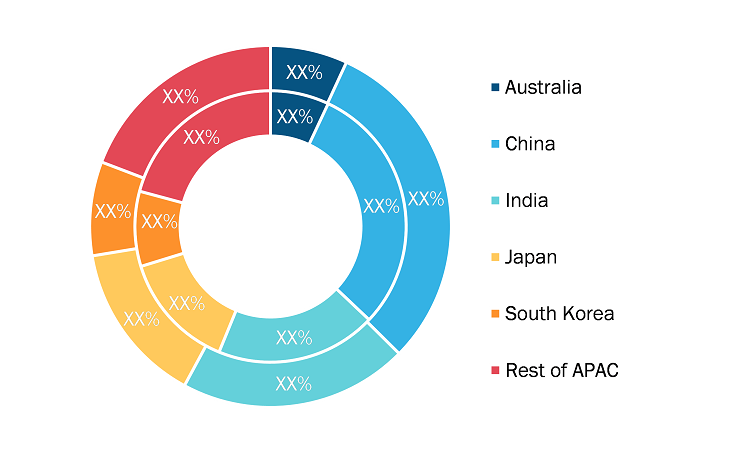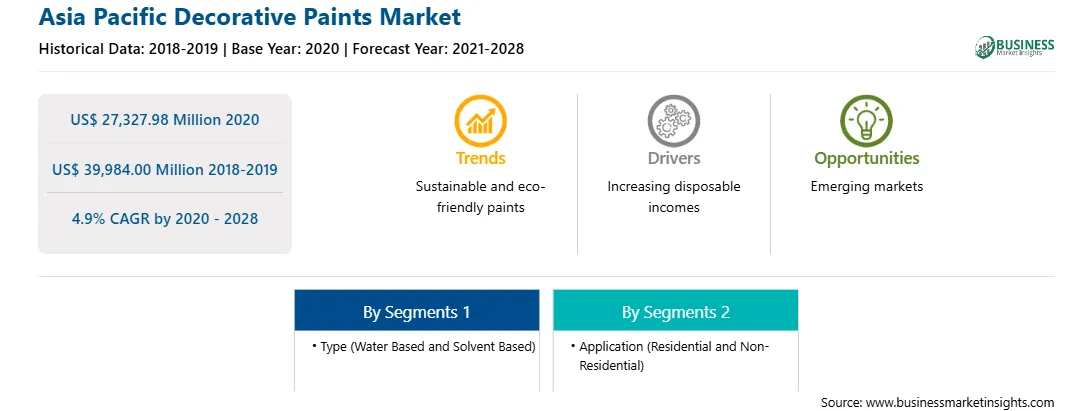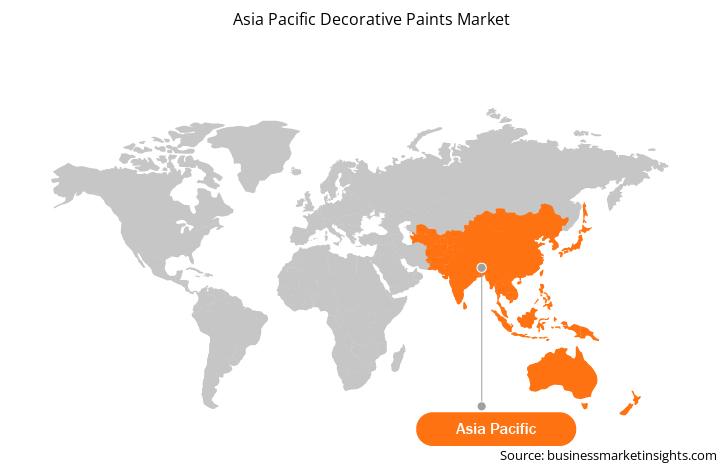The Asia Pacific region comprises developed and developing countries such as Australia, China, India, Japan, South Korea, and other Asian countries. The growth of the decorative paints market in the Asia Pacific region is mainly attributed to government authorities' rising focus on infrastructural development in countries like China, Japan, and India. The government of developing countries, especially India, is investing heavily in infrastructure development, such as buildings and other physical structures. As a result, the use of decorative paints becomes inevitable and drives the growth of the decorative paints market in the Asia Pacific. In Asia-Pacific, China is the largest economy in terms of GDP. The country witnessed about 6.1% growth in its GDP during 2019, even after the trade disturbance caused due to its trade war with the United States. However, due to the onset of COVID-19 in 2020, China's economic growth is estimated to contract to 1.90%, and it is expected to witness recovery at a rate of 8.20% in 2021. The Asia Pacific hosts a vast construction sector, especially China. The developments in the residential and non-residential sectors in the past two years have supported the construction sector's growth at large, both in volume and value. China has been primarily driven by the ample developments in the residential and non-residential construction sectors supported by the growing economy. Unfortunately, due to the pandemic scenario, several countries in the region went into lockdown, halting all the manufacturing and construction activities, thus negatively impacting the demand in the decorative paints market. However, the condition is anticipated to recover in 2021, thereby restoring the growth trajectory of the market. Further, cheap labor and easy access to the architectural industry attract designing buildings and other physical structures activities in the country.
The government of Asia Pacific is taking possible steps to reduce its effects by announcing lockdown, and thus, impact the revenue generated by the market. The Government have asked the chemicals & materials manufacturers to delay their production which will adversely affect the global supply of decorative paints. The construction industry is one of the hardest hit industries by COVID-19. In India, one of the largest constraints that the construction industry faced was the shortage of labor, which was due to the lockdowns, as there were difficulty sourcing migrant workers which is an integral part of the construction sector.

Strategic insights for the Asia Pacific Decorative Paints provides data-driven analysis of the industry landscape, including current trends, key players, and regional nuances. These insights offer actionable recommendations, enabling readers to differentiate themselves from competitors by identifying untapped segments or developing unique value propositions. Leveraging data analytics, these insights help industry players anticipate the market shifts, whether investors, manufacturers, or other stakeholders. A future-oriented perspective is essential, helping stakeholders anticipate market shifts and position themselves for long-term success in this dynamic region. Ultimately, effective strategic insights empower readers to make informed decisions that drive profitability and achieve their business objectives within the market.

| Report Attribute | Details |
|---|---|
| Market size in 2020 | US$ 27,327.98 Million |
| Market Size by 2028 | US$ 39,984.00 Million |
| Global CAGR (2020 - 2028) | 4.9% |
| Historical Data | 2018-2019 |
| Forecast period | 2021-2028 |
| Segments Covered |
By Type
|
| Regions and Countries Covered | Asia-Pacific
|
| Market leaders and key company profiles |
The geographic scope of the Asia Pacific Decorative Paints refers to the specific areas in which a business operates and competes. Understanding local distinctions, such as diverse consumer preferences (e.g., demand for specific plug types or battery backup durations), varying economic conditions, and regulatory environments, is crucial for tailoring strategies to specific markets. Businesses can expand their reach by identifying underserved areas or adapting their offerings to meet local demands. A clear market focus allows for more effective resource allocation, targeted marketing campaigns, and better positioning against local competitors, ultimately driving growth in those targeted areas.

The decorative paints market in Asia Pacific is expected to grow to US$ 39,984.00 million by 2028 from US$ 27,327.98 million in 2020. The market is estimated to grow at a CAGR of 4.9% from 2020 to 2028. Construction is considered to be one of the most dynamic industrial sectors which are significantly related to the evolution of better societies across the world. With the rise in disposable income along with shift in lifestyle and change in working demographics, need for better residential and commercial spaces, the need for architectural facilities have risen, thereby, promoting growth of construction industry. The growth of the market is supported by increased expenditure of government towards construction sector coupled with recovering labor market, strong credit growth and positive measures undertaken by government. The growth in residential and commercial sector along with new renovation activities is expected to promote the demand for decorative paints. The use of decorative paints across commercial and residential buildings is expected to provide growth opportunities of the market. Such paints are widely used at homes, complexes, offices, and other spaces. The demand for decorative paints is rising from the construction sector as they help to enhance the interiors and exteriors of buildings with different finishes including eggshell and satin, matte finish, gloss and others. Further, such paints are widely used in several construction operations such as wall paints, roof coatings and other finishes for better appeal. Positive government measures coupled with increased investment towards building and construction sector is expected to fuel the demand for decorative paints in the market.
Asia Pacific decorative paints market is segmented based on type and application. The Asia Pacific decorative paints market based on type is segmented into water based and solvent based. Water based segment accounted for the highest share in the market in 2019 and is expected to be fastest growing during forecast period. Based on application, is segmented into residential and non-residential. Residential segment accounted for the highest share in 2019 and non-residential segment is expected to be the fastest growing during forecast period.
A few major primary and secondary sources referred to for preparing this report on decorative paints market in Asia Pacific are company websites, annual reports, financial reports, national government documents, and statistical database, among others. Major companies listed in the report are Akzo Nobel N.V.; BASF SE; Dow Inc.; Axalta Coating Systems; PPG Industries Inc.; RPM International Inc.; Kansai; Asian Paints; and Nippon Paints among others.
The Asia Pacific Decorative Paints Market is valued at US$ 27,327.98 Million in 2020, it is projected to reach US$ 39,984.00 Million by 2028.
As per our report Asia Pacific Decorative Paints Market, the market size is valued at US$ 27,327.98 Million in 2020, projecting it to reach US$ 39,984.00 Million by 2028. This translates to a CAGR of approximately 4.9% during the forecast period.
The Asia Pacific Decorative Paints Market report typically cover these key segments-
The historic period, base year, and forecast period can vary slightly depending on the specific market research report. However, for the Asia Pacific Decorative Paints Market report:
The Asia Pacific Decorative Paints Market is populated by several key players, each contributing to its growth and innovation. Some of the major players include:
The Asia Pacific Decorative Paints Market report is valuable for diverse stakeholders, including:
Essentially, anyone involved in or considering involvement in the Asia Pacific Decorative Paints Market value chain can benefit from the information contained in a comprehensive market report.